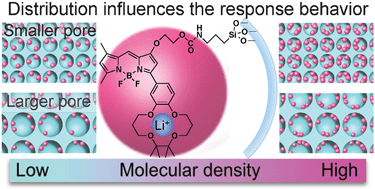This paper describes the development and the characterization of a Li+ optical sensor (optode) based on a Li+ selective fluoroionophore (KBL-01-Si), immobilized to a mesoporous silica thin film. KBL-01-Si was synthesized by the formation of a urethane bond between the hydroxyl terminated alkoxy chain of KBL-01 and 3-isocyanatopropyl-triethoxysilane. Li+ optodes with different amounts of KBL-01-Si fluoroionophore were fabricated by changing the grafting time of KBL-01-Si to mesoporous silica thin films with two different pore sizes. When the concentration of KBL-01-Si immobilized to the pore surface of the mesoporous silica thin films was low, response curves following a theoretical 1 : 1 complex formation equilibrium with binding constants for Li+ (log K) between 4.38 and 5.04 were observed. At higher concentrations of immobilized fluoroionophore, the response curves deviated from the fitting curve based on a theoretical chemical equilibrium, and the dynamic response was extended over a broad range from 10−6 to 1 M. In addition, it was observed by XPS depth profiling that KBL-01-Si was mainly localized on pore surface areas close to the channel entrances. These results indicate that not only the design of the fluoroionophore, but also the matrix for immobilization, and the microscale distribution of the fluoroionophore affect the characteristics of an ion sensor.

You have access to this article
 Please wait while we load your content...
Something went wrong. Try again?
Please wait while we load your content...
Something went wrong. Try again?


 Please wait while we load your content...
Please wait while we load your content...